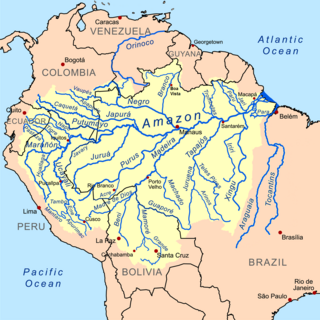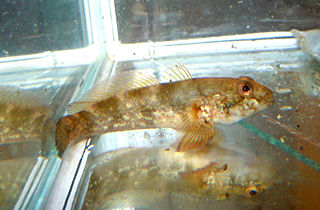
The Amazon Basin is the part of South America drained by the Amazon River and its tributaries. The Amazon drainage basin covers an area of about 6,300,000 km2 (2,400,000 sq mi), or about 35.5 percent of the South American continent. It is located in the countries of Bolivia, Brazil, Colombia, Ecuador, French Guiana (France), Guyana, Peru, Suriname, and Venezuela.

The round goby is a fish. Defined as a euryhaline bottom-dwelling goby of the family Gobiidae, it is native to central Eurasia, including the Black Sea and the Caspian Sea. Round gobies have established large non-native populations in the Baltic Sea, several major Eurasian rivers, and the North American Great Lakes.

The monkey goby is a species of goby native to the basins of the Black Sea and the Sea of Azov.

Ponticola kessleri, the bighead goby or Kessler's goby, is a species of goby native to Eurasia. The bighead goby is a Ponto-Caspian relict species. It inhabits the fresh and oligohaline waters, with mineralisation from 0-0.5‰ up to 1.5-3.0‰.

The Syrman goby is a species of goby native to marine, brackish and probably fresh waters of the Black Sea, the Sea of Azov and the Caspian Sea basins. They inhabit inshore waters with substrates composed of shell fragments, sand, mud or muddy sand. This species can reach a length of 24.5 centimetres (9.6 in) TL.

The western tubenose goby is a species of goby native to fresh waters of the Black Sea and Aegean Sea basins,. It has recently spread as an invasive species to Central and Western Europe and to North America. Previously Proterorhinus semilunaris was considered as a junior synonym of Proterorhinus marmoratus, but was confirmed as a distinct species based on molecular analysis.

Ponticola is a genus of gobies native mostly to fresh waters of the Black Sea - Caspian Sea region in Eurasia. Some species occur in the brackish-water Black and Caspian seas themselves. It was considered to be part of the broader goby subfamily Benthophilinae, also endemic to the same region, although the 5th edition of Fishes of the World does not list any subfamilies in the Gobiidae. Originally, Ponticola was described as subgenus of Neogobius.

The mushroom goby is a species of goby native to the Black Sea where it can be found along the coasts from Bulgaria to the Crimea. Mostly a species of marine and brackish waters, it is known to enter fresh waters in the delta of the Danube River. This species prefers inshore waters with rocks or fallen trees. This species can reach a length of 20 centimetres (7.9 in) TL.

The stellate tadpole-goby is a species of gobiid fish native to the basin of the Sea of Azov where it occurs in the Gulf of Taganrog and limans of the eastern coast. It also lives in the lower Don River up to the Tsimlyansk Reservoir. It occurs in fresh and brackish waters of depths greater than 3 metres (9.8 ft), preferring shallow coastal lagoons and lowland rivers. Males can reach a length of 13.5 centimetres (5.3 in) TL while females only reach 11 centimetres (4.3 in) TL.

Pinchuk's goby is a species of goby native to the Black Sea and the Sea of Azov.

The ratan goby is a species of goby native to brackish and marine waters of the Black Sea, the Sea of Azov and the Caspian Sea. In the Caspian Sea it is presented by subspecies Ponticola ratan goebeli. It occurs in inshore waters, inhabiting areas with stone or gravel substrates. This species can reach a length of 20 centimetres (7.9 in) TL.
The Caucasian goby is a species of goby native to rivers of the Caucasus draining to the Black Sea in Europe and Asia. This species is strictly a fresh water species and will not enter brackish water. It can reach a length of 20 centimetres (7.9 in) SL.

Ponticola cyrius, the Kura goby, is a species of gobiid fish endemic to the Kura River in the southern Caucasus countries of Georgia, Turkey, Iran and Azerbaijan. It reaches a length of 13 centimetres (5.1 in) SL. It lives in the upper parts of the Kura River, Massuleh River and the Pasikhan River and in the Anzali Mordab (Iran). Downstream in Kura it is replaced by Ponticola gorlap.

The Black Sea tadpole-goby is a species of goby native to the basin of the Black Sea. Found in the Gulf of Tendra and limans of the north-western Black Sea, lakes of the Danube Delta. In the rivers of the Black Sea basin: Danube up to Iron Gate dam, Dniester up to Tighina, Dnieper up to Kyiv, Southern Bug. This species is mostly a denizen of fresh and slightly brackish bodies of water, preferring rivers and deltas, limans and coastal lakes. This fish can reach a length of 15 centimetres (5.9 in) TL.

Ponticola gorlap, or the Caspian bighead goby, is a species of goby, a benthic fish native to the Caspian Sea basin. It is widespread in lower parts of many rivers in Iran, and also found in Azerbaijan and Turkmenistan. In Russia, it occurred in the lowest part of the Volga River up to Astrakhan until 1977, but has thereafter spread upstream. In 2000 it was recorded as being established in the Ivankovo and Rybinsk Reservoirs in the Moscow region, and already invaded the Don drainage by way of the Volga-Don Canal in 1972. This species occurs in sheltered environments, such as inshore fresh or brackish waters of estuaries, lagoons, lakes and large rivers, where it prefers habitats with a well vegetated rock or firmly packed sand substrate. It can reach a length of 20 centimetres (7.9 in) SL, and a common size is 12 centimetres (4.7 in) SL.
Turan's goby is a Ponto-Caspian species of goby endemic fish native to Turkey where it is only found in the Aksu Deresi stream. This species is found in a fresh water stream with a substrate of rounded pebbles. Males of this species can reach a length of 8.8 centimetres (3.5 in) SL while females only reach 8.3 centimetres (3.3 in) SL.

The Benthophilinae are a subfamily of gobies endemic to the Ponto-Caspian region. The subfamily includes about 50 species. The representatives of the subfamily have fused pelvic fins and elongated dorsal and anal fins. They are distinguished from the closely related subfamily Gobiinae by the absence of a swimbladder in adults and location of the uppermost rays of the pectoral fins within the fin membrane.

True gobies were a subfamily, the Gobiinae, of the goby family Gobiidae, although the 5th edition of the Fishes of the World does not subdivide the Gobiidae into subfamilies. They are found in all oceans and a few rivers and lakes, but most live in warm waters. Altogether, the Gobiinae unite about 1149 described species in 160 genera, and new ones are still being discovered in numbers.

Ponticola bathybius is a species of goby endemic to the Caspian Sea, where it occurs in depths down to 200 metres (660 ft). It is strictly confined to the brackish-water basin and does not enter fresh waters. It can grow up to a length of 25 centimetres (9.8 in) TL.

Rhinogobius flumineus, commonly known as the lizard goby or kawa-yoshinobori, is a species of goby endemic to Japan where it is found in the mid- to upper reaches of fast-flowing rivers. This species can reach a length of 7 centimetres (2.8 in) TL.
















